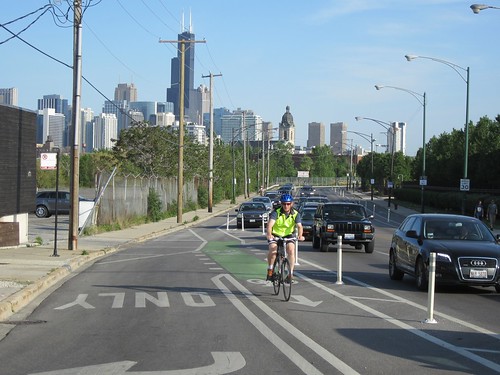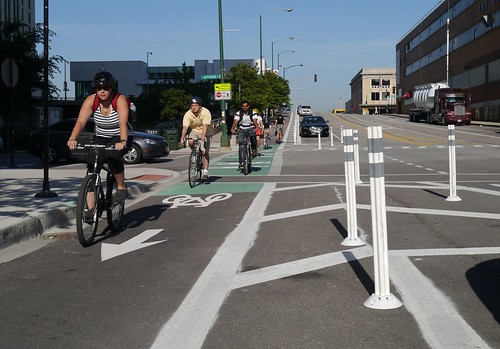For years, Illinois Governor Pat Quinn has been an enthusiastic supporter of walking, biking and transit initiatives. In 2001 he hiked from the Mississippi River to Lake Michigan to draw attention to the need for universal healthcare, and he later launched the Walk Across Illinois fitness challenge, encouraging residents to walk 190 miles within one year, an equivalent distance.
In 2005, as lieutenant governor, he successfully pressured Metra to grant access to bicycles. As governor, in 2010 he signed the Protecting Cyclists and Pedestrians from Harassment Act, which makes it a crime to drive unnecessarily close to vulnerable road users; if the violation results in a serious injury the motorist can be charged with a felony.
Because of Quinn’s history as an advocate for sustainable transportation and safe streets, it seemed unlikely that the governor would support the Illinois Department of Transportation’s ban on protected bike lanes on state jurisdiction roads. Protected lanes have been successfully implemented in Europe for decades, and they’ve been shown to significantly improve safety for all road users, as well as promote commerce, in other U.S. cities like New York, which has been installing them since 2007.
However, earlier this year Steven Vance reported that IDOT has been blocking the Chicago Department of Transportation from installing protected lanes on state roads in our city, at least until CDOT provides three years of “safety data” on protected lanes on other Chicago streets. Since the Kinzie Street protected lanes were opened in July 2011, that means the ban will be in place for at least another year.
This is a major constraint on CDOT’s ability to create safer streets. IDOT is currently developing a state bicycle transportation plan, but its illogical protected bike lane policy has undermined Chicagoans’ confidence that the department actually cares about improving safety for cyclists, as shown by comments at a recent public meeting on the plan. There is suspicion that the notoriously car-centric agency is actually more interested in preventing excess travel lanes or on-street parking from being converted to protected bike lanes, or perhaps there is some unknown political motivation behind the ban.
I had assumed that our pro-bike governor simply hadn't heard about the ban, so I was extremely disappointed to learn this is not the case. “Governor Quinn is aware of the prohibition on protected bike lanes and the fact that IDOT is studying these over multiple years,” said Quinn’s spokesman David Blanchette. “He has a strong record on sustainable transportation and environmental issues, but he also has great confidence in the people he appointed to run IDOT, and when they say they need more time, he respects that decision. The governor is a big fan of walking and bicycling and does both activities regularly. He’s also a Chicago resident so he’s very aware of these issues.”
“There are reasons why IDOT requires a certain amount of time to do studies,” Blanchette added. “They have certain time frames that they like to observe on studies of this kind because they want to make sure the safety of pedestrians, bicyclists and motorists isn’t shortchanged.”
But why is additional study necessary when protected lanes have a proven safety record in peer cities like New York? “Every city is different,” Blanchette responded. “They each have their unique transportation situations and we want to make sure the study takes account of Chicago’s unique situation.” To me, this sounds like a rationalization from a state transportation department that simply does not want protected lanes on its streets.
Blanchette assured me that Quinn has spoken with his communications staff, as well as IDOT chief Ann Schneider, about the protected lane ban, but it’s still hard to believe that our progressive governor is on the wrong side of this issue. In the near future, we’ll be working with Quinn’s office and IDOT to get more information on the decision process behind the prohibition, and we’ll keep you posted on what we find out.







